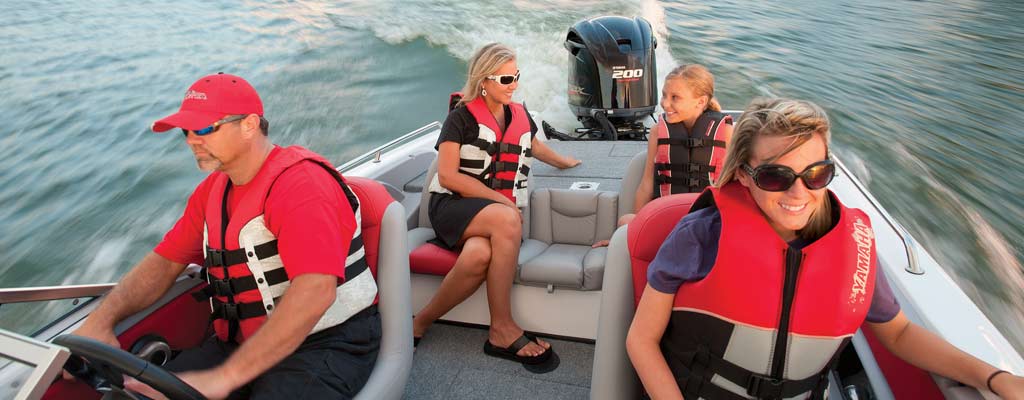Different Types of Life Jackets
Different Life Jackets for Different Boating Activities
Below is a brief description of each type of life jacket, their intended use and the buoyancy they provide.

Type I – Inherently buoyant recommended uses and features:
Intended Use:
When cruising, racing and fishing offshore , or when boating alone, or in stormy conditions.
Minimum Buoyancy:
22 lbs. for adults. (11 lbs. for child size)
Additional Information:
Best for open, rough or remote water where rescue may be slow to arrive. Will turn MOST unconscious wearers face-up in water.
Offers the best protection, but is somewhat bulky and uncomfortable. Does the best job of retaining body heat, as it has additional foam and fabric, and keeps your head higher above water.
Currently, there aren't any Coast Guard approved Type I inflatable PFD's available to the general public.

Type II – Inherently buoyant recommended uses and features:
Intended Use:
Inland day cruising, fishing and sailing. Good for boating in light craft.
Minimum Buoyancy:
15.5 lbs. for adult size.
Additional Information:
Good for protected, inland water near shore, where chances of immediate rescue is good. Not suitable for extended survival in rough water. Will turn SOME unconscious wearers face-up in water. Poor performer in rough water, often requires you to tread water in order to keep your head above water.
More comfortable but less buoyant than Type I. Provides far less flotation than a Type I.
Type II - Inflatable recommended uses and features:
Intended Use:
For serious inland and near shore cruising.
Minimum Buoyancy:
34 lbs. for adult size.
Additional Information:
Not guaranteed to turn unconscious wearer face-up.
Advantages: very comfortable, more buoyant than Type II Inherently Buoyant jackets.
Disadvantages: High price; may be manual or automatic.
There are many Type V (special use) inflatable jackets (covered later in this section) that provide Type II performance characteristics.
Inflatable PFDs are not meant for children under the age of 16.

Type III – Inherently buoyant recommended uses and features:
Intended Use:
Supervised activities, such as sailing regattas, dinghy races, water skiing, fishing, canoeing, kayaking and during personal watercraft operation.
Minimum Buoyancy:
15.5 lbs. for adult size.
Additional Information:
Good for protected, inland water near shore, where chance of immediate rescue is good.
Not suitable for extended survival in rough water. Not designed to turn unconscious people face up in water.
More comfortable to wear than a Type I or a Type II, but provides far less floatation than a Type I.
Read More About This Topic
- Life Jackets are for Everyone
- How to Care for Your Life Jackets
- Inflatable Life Jacket Care Infographic
Type III – Inflatable recommended uses and features:
Intended Use:
For boating inshore and near shore and for supervised activities such as sailing regattas, dinghy races, canoeing.
Minimum Buoyancy:
22.5 lbs. for adult size.
Additional Information:
Not guaranteed to turn unconscious wearer face-up.
Advantages: more comfortable than a Type III Inherently Buoyant jacket.
Disadvantages: one manual inflation mechanism only.
Inflatable PFDs are not meant for children under the age of 16.

Type IV – Throwable Device:
Intended Use:
A Type IV is designed to be thrown to an overboard victim or to supplement the buoyancy of a person overboard. It is not to be worn. Minimum buoyancy: 16.5 lbs. for ring buoy or 18 lbs. for boat cushion.
Additional Information:
A Type IV throwable device can be a square style, or a ring buoy or horseshoe buoy mounted on deck.
A Type IV is not for unconscious persons, non-swimmers or children. Although these devices are often referred to as seat cushions, you should never use it as such. This degrades the foam and reduces the amount of floatation that is provided.
NOTE - Type IV devices must be IMMEDIATELY AVAILABLE for use. You must have one at arm's length to throw over the side in an emergency. Having one in a locker under the driver's seat isn't considered "immediately available."


Type V – Special use life jackets:
Intended Use:
Restricted to the special use for which each is designed, for example: sailboard harness, deck suit, paddling vest, commercial white water vest or float coats.
Minimum Buoyancy:
15.5 to 22 lbs. for adult size.
Additional Information:
Must be worn when underway to meet minimum US Coast Guard requirements. Simply having a Type V PFD on board will not meet the USCG carriage requirements.
Type V – Automatic inflation models:
Intended Use:
Restricted to the one use for which it is designed, ex. belt pack, deck suit, float coat.
Minimum Buoyancy:
22.5 to 34 lbs. depending on style.
Additional Information:
Must be worn to meet federal requirements.
Not guaranteed to turn an unconscious wearer face-up. Some manufacturers claim Type II performance. Some models feature a combination of CO2 inflation and built-in foam and provide 15.5 to 22 lbs. of buoyancy.
Type V – Hybrid Inflation and some special notes:
Intended Use:
Models recommended for boating activities where rescue is nearby and must be worn when underway.
Minimum Buoyancy:
Have 7.5 lbs. of built-in foam buoyancy and can be inflated to 22 lbs.
Additional Information:
More comfortable to wear than Type I or Type II, but are inadequate for unconscious overboard victims.
Inflation Mechanism: When activated, a CO2 cartridge is pierced, releasing gas to inflate the device. Water-activated models inflate automatically when submerged in water.
Manual units are activated by yanking a pull-tab. Both types of inflatables feature blow-tubes to provide a back-up method of inflation. It is important to follow the manufacturer's instructions for checking and maintaining your inflation mechanism.

